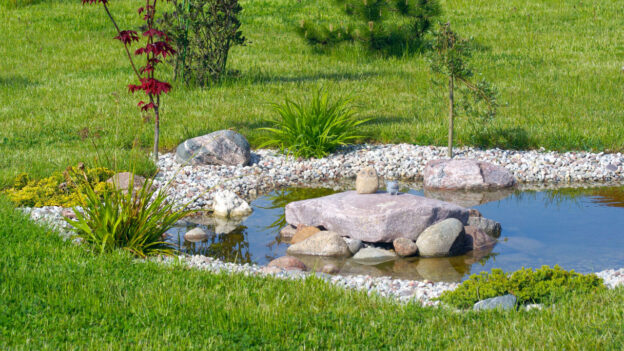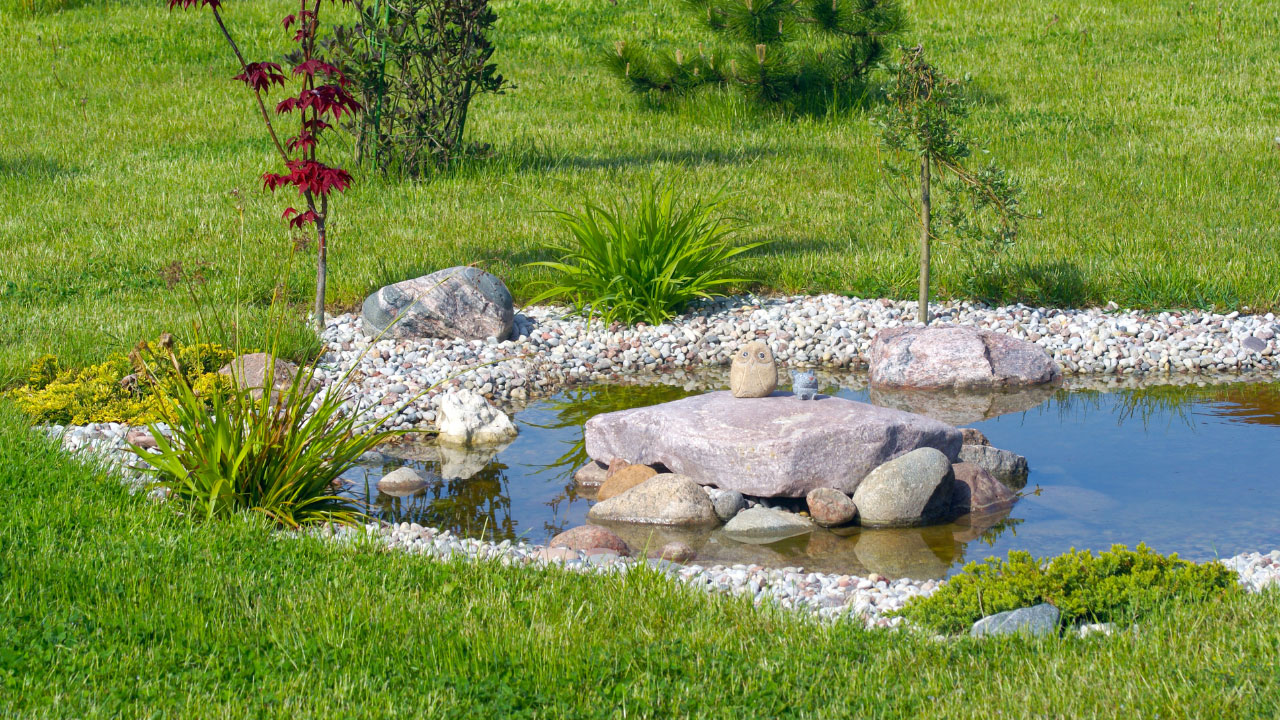Key Takeaways
- Regularly check your pond’s water level and inspect the liner and surroundings to quickly identify any leaks.
- Small leaks in pond liners can often be fixed using DIY repair kits that include patches and sealants.
- For complex issues or recurring leaks, seek professional services to ensure a thorough and lasting repair.
- Use good materials. Ensure proper installation. Also, do routine maintenance. Doing this will minimize the risk of future leaks.
- Employ natural elements like appropriate vegetation and wildlife management to help maintain the integrity of the pond and prevent leaks.
Pond leaks can be a significant hassle for any pond owner, leading to increased maintenance efforts and costs. More importantly, leaks can harm the pond’s ecosystem, affecting plant and animal life. Detecting and repairing these leaks promptly is crucial for maintaining the health and beauty of your pond. To detect a pond leak, monitor water levels for unusual decreases and inspect the liner and surrounding area; address repairs with appropriate sealants, patches, or professional help depending on the severity of the leak.
This comprehensive guide explores practical tips for identifying potential leaks, details on DIY repair methods, and advice on when to call in the professional pond designers Orange County.
Understanding Pond Leaks
Pond leaks can occur due to a variety of reasons:
- Natural Evaporation: It’s normal for ponds to lose some water to evaporation, especially in hot weather. However, if the water loss is rapid and significant, it might indicate a leak rather than just natural processes.
- Liner Edge Damage: The edges of pond liners can get damaged by wear or wildlife activity, leading to leaks.
- Liner Failures: Tears or punctures in the pond liner itself are common sources of leaks and need immediate attention.
- Skimmer Box Issues: Faulty skimmer boxes can also lead to significant water loss and should be checked regularly.
- Increased Water Loss During Hot Weather: Apart from evaporation, splashing and overflow can also contribute to water loss during hot seasons.
Detecting Pond Leaks
Detecting a leak in your pond involves several steps:
- Monitoring Water Levels: Keep a regular check on the water level. A sudden drop might indicate a leak.
- Thorough Inspections: Examine all parts of your pond, including the liner and nearby areas, for signs of escaping water.
- Using Dye Tests: Dye tests can help pinpoint the exact location of a leak. By adding dye to the water and observing where it flows or seeps out, you can identify the affected area.
These methods are fundamental in ensuring you catch and manage leaks before they lead to more severe problems like structural damage to your pond or increased utility bills due to constant refilling.
DIY Repair Techniques
Patching Small Leaks in Pond Liners: For minor tears or holes, using a pond liner repair kit is highly effective. These kits typically include a patch that can seal the tear and a primer to prepare the surface. First, locate the tear and clean the area around it thoroughly. Apply the primer, then place the patch over the tear, pressing firmly to ensure it adheres well. Using a roller from the kit, press over the patch to remove any air bubbles, ensuring a tight seal.
Replacing Damaged Pond Liners: If the damage to your pond liner is extensive, replacing it might be necessary. Start by removing any water, plants, or fish from your pond. Carefully remove the old liner, making sure not to cause further damage to the surrounding area. Place the new liner evenly, ensuring it fits snugly against the pond’s contours before slowly refilling the pond. It’s important to allow the liner to settle naturally to avoid stretching or tearing. It is advisable to consult a professional for the right pond fountain parts and supplies Orange County when replacing the damaged parts.
Fixing Leaks in Pond Pipes or Skimmer Boxes: Leaks in pipes or skimmer boxes can often be sealed with waterproof sealants designed for pond use. Ensure the area is dry and clean before applying the sealant to achieve the best results. For skimmer boxes, check for cracks or loose connections and apply sealant as needed. Regular maintenance and checks can prevent these issues from recurring.
When To Call The Professionals
Recognizing the Need for Expert Help: If you’ve attempted repairs and the problems persist, or if the leak is complex and involves critical components like plumbing or filtration systems, it’s wise to consult with a professional. Recurring leaks might indicate a more serious underlying issue that could require comprehensive diagnostics.
Benefits of Professional Pond Repair Services: Professional services offer long-term solutions that can save you time and money. Experts have the tools and experience to diagnose issues quickly and efficiently. Their repairs often come with guarantees, providing peace of mind that the problem is resolved. Moreover, professional intervention can prevent minor issues from escalating into major repairs, preserving the structural integrity and aesthetic of your pond.
Encouraging Professional Consultation: While DIY methods are great for minor issues, significant or persistent problems should be handled by professionals. They can provide detailed assessments and tailored solutions that ensure the health and longevity of your pond. Contacting a reputable pond repair service not only helps to quickly address leaks but also contributes to the overall well-being of the pond ecosystem.
Preventing Future Leaks
To ensure the longevity of your pond and minimize the risk of future leaks, here are several preventative measures based on updated and effective practices:
Regular Inspections and Maintenance: Conduct regular inspections of your pond, focusing on the liner and associated equipment such as pumps and filtration systems. Check for any signs of wear, tear, or damage, and address these issues promptly to prevent them from worsening.
Proper Installation Practices: When installing or replacing pond liners or other critical components, ensure that everything is correctly placed and functioning. This includes ensuring that the liner is free from sharp objects underneath, using the right type of liner material such as EPDM or PVC, and ensuring proper sealing around all edges and fixtures.
Routine Checks After Extreme Weather Conditions: Weather conditions like heavy rain, snow, and cycles of freezing and thawing can strain your pond’s structure. After such events, it’s crucial to check the integrity of the pond liner and the surrounding areas for any potential damage or displacement that might have occurred.
Use of High-Quality Materials: Opt for high-quality materials that are suitable for your local conditions and the specific needs of your pond. This includes selecting appropriate types of liners and other sealing materials that offer durability and resistance to environmental factors.
Employing Natural and Engineered Solutions: Consider using natural clays like bentonite for sealing soil-based liners or engineered solutions like geotextiles for additional protection. These materials can help prevent water seepage by forming a robust barrier against leaks.
Integrative Plant and Wildlife Management: Incorporate suitable plants around the pond’s perimeter to help stabilize the soil and absorb excess water. Additionally, manage wildlife interaction with the pond, as animals can cause damage that leads to leaks. Using barriers or deterrents can be effective in protecting the pond liner from potential harm caused by wildlife.
Frequently Asked Questions
How do I know if my pond is leaking?
Look for signs like unexplained drops in water levels. Also, look for soggy ground around the pond or extra algae growth from excess groundwater nutrients.
Can small leaks in pond liners be repaired by homeowners?
Yes, small leaks can often be fixed using DIY patch kits. These kits are made for pond liners and include all the materials for a simple repair.
What are some common causes of pond leaks?
Common causes include damage to the liner, like tears or punctures. Also, degradation of seals around pipes or fittings and natural wear and tear over time.
How often should I inspect my pond for leaks?
You should inspect the liner at least once a season. Do extra checks after severe weather that could harm it or the structure.
What should I do if I can’t locate the leak?
If you can’t find the leak’s source, consider hiring professionals. They have the tools and skill to do more advanced tests.
Is it better to repair or replace a damaged pond liner?
This depends on the extent of the damage. You can fix small punctures or tears. But, you might need to replace the liner for larger damage. This is to keep the pond from leaking.
Partner With OC Pond Fountain Service Today To Address Leaks In Your Pond
Promptly addressing leaks in your pond is crucial for maintaining a healthy aquatic environment. While many minor repairs can be handled with DIY solutions, more complex issues often require professional intervention. Partnering with skilled pond designers Orange County like OC Pond Fountain Service ensures that your pond repairs are handled efficiently and effectively, preserving the beauty and stability of your pond for years to come.
Don’t let a small leak turn into a big problem! Contact OC Pond Fountain Service today to schedule a consultation. Our experts are ready to help you with all your pond maintenance and repair needs, ensuring your pond remains a perfect oasis.

